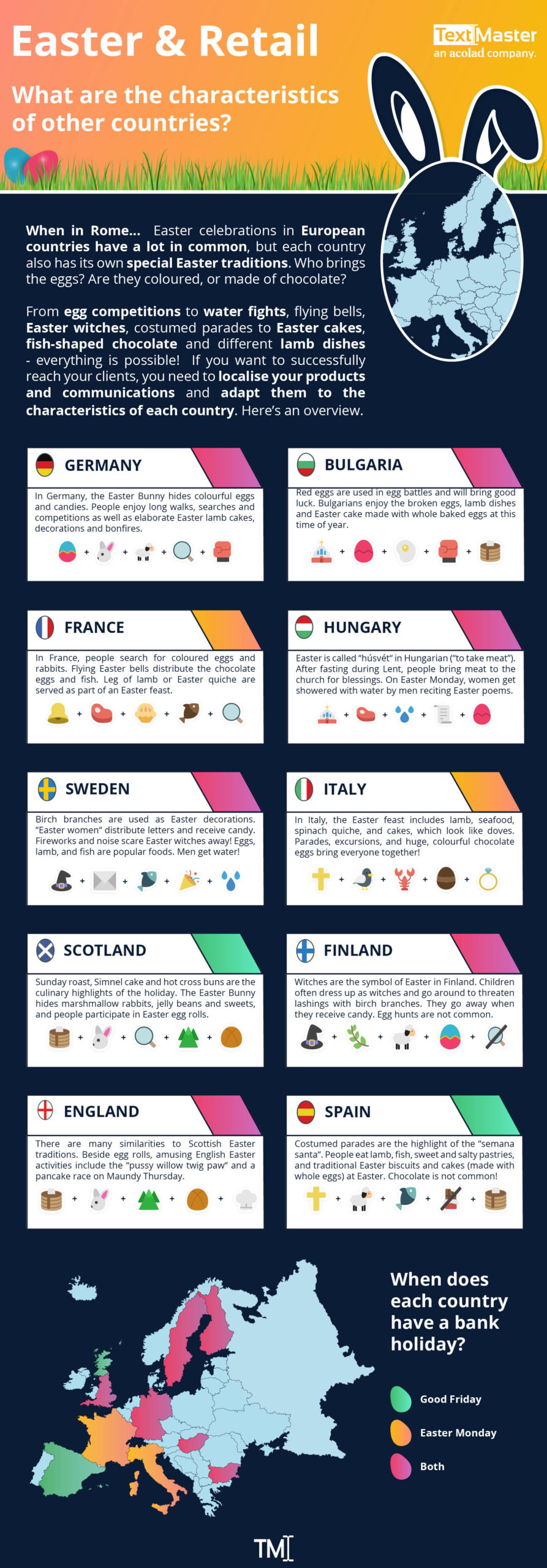In Europe, what people associate with Easter will depend on the specific country they’re in. Despite a number of common features, different countries have developed some curious Easter customs. So, who brings the Easter eggs? And are these hen’s eggs painted in bright colours, or just chocolate eggs? From egg and water fights to travelling church bells, flying witches, and costume parades to local cakes, fish chocolate and lamb dishes, it’s all here – If you want to successfully reach your clients, you need to localise your products and communications and adapt them to the characteristics of each country. Here’s an overview.
Easter time is retail time!
However, it’s not only the food industry and retail that are in demand around the Easter period, the tourism, outdoor, lifestyle and eCommerce sectors are as well.
Online shopping is more popular than ever, especially during the holidays, as it is less stressful and more convenient. Easter gifts are enjoying increasing popularity. What gifts are given? This depends on the country, however, in Germany for instance, sweets, chocolate, painted boiled eggs, flowers & plants, toys, books, clothing, shoes, beverages and culinary treats all play a role. Online trade is booming.
Would you like to know more about localisation and translation?
Is the “German” Easter Bunny a successful export at Easter??
Statistics from 2017 have already revealed the number of chocolate bunnies that are produced in Germany at Easter time: around 200 million Easter Bunnies are produced in Germany each year, and approximately 90 million are exported abroad.
However, did you know that in other European countries the “German” Easter Bunny plays barely any role at all? And that Easter time is a time where “fertility” is celebrated?
In spite of the similarities, often due to religion, very different customs have developed in many countries. We took a closer look and have picked out some Easter-related facts that may have an effect on your local sales in various countries. Localisation is becoming more and more important to your business’ success – don’t believe us yet? See for yourself – you’ll be surprised.

Download infographic as PDF
Germany
In Germany, the Easter Bunny brings hen’s eggs, often dyed and painted in bright colours, as well as other sweets such as chocolate Easter Bunnies and eggs.
Often a so-called Easter nest is created (a basket with the treats, along with artificial grass) and then hidden so that young and old alike can hunt for it. Hiding places can be picked out in your home garden, or on a beautiful walk. Does this sound strange? There are even large organised events for this or competitions such as competitive egg-eating, egg-and-spoon racing or “Eierditschen” (here, eggs are hit against one another and the winner is the person whose egg doesn’t break) etc. Also not to be forgotten: the traditional Easter Lamb (cake), the Easter bonfire custom as well as the typical decorations such as coloured eggs (blown or made of plastic,) and bunches of pussy willow and daffodils (known as Osterglocken, literally “Easter Bells”).
France
In France there are only chocolate eggs, and dyed and painted hen’s eggs are uncommon. A hunt for Easter eggs is a common feature, however for our French neighbours, it is a “bell” that brings the eggs! To be precise, children are told that the church bells, which are silent from Holy Thursday onwards, have flown to Rome to collect their blessing for the coming year. On the journey home, packed full of sweets, they drop fish and seafood made of chocolate over fields, meadows and gardens. Good Friday is not a public holiday, and the holiday begins on Easter Sunday. Celebrations are enjoyed as a family with traditional meals such as leg of lamb or Easter quiche. The daffodil is also very popular here.
Hungary
Traditionally, Hungarians abstain from eating meat throughout the entire Lent period. The Hungarian word for Easter is “húsvét” and more or less means “take meat”, and many people bring meat with them to church to have it blessed before they eat it. However, this is not the only unique Easter custom: on Easter Monday, women and girls have buckets of water poured over them by men reciting Easter poems! The so-called “dousing” is a farming tradition and is meant to promote fertility – women are said to “bloom” and “flourish”. Nowadays, it is more common for them to be sprayed with water or perfume. By way of thanks, the men then receive a red Easter egg. In Poland they have a custom like this where they celebrate “Wet Monday” – however, without any poetry.
Bulgaria
In Bulgaria the eggs are only painted red – symbolising the blood of Jesus. Once the paint is ready, the eldest in the house uses it to paint the children’s faces to bless them with health and strength. There is no hiding or hunting for eggs, but both young and old do get to have some fun, with an “egg throwing contest” taking place immediately after Easter Sunday mass. Eggs are thrown at the church walls, and whoever’s egg remains intact has won a year of success. Traditionally, a lamb dish and a cake (with an egg still in the shell baked in) are then enjoyed, along with all of the previously broken eggs. Other eggs are broken during “egg fights”. The loser must eat his broken egg immediately.
Spain
Holy Week, or “Semana Santa” sees believers in gowns with tall hoods carry holy statues in parades through the streets. As they do so, hymns are sung to commemorate the Passion of Christ. On Easter Sunday, the Spanish celebrate together as a family. Traditional dishes include roast lamb, stockfish, sweet or savoury filled pasties in various forms (“Panades” or “Robiols”) as well as a traditional Easter cake (Monas de Pascua) made from leavened dough, including a baked egg with the shell left on. This is cracked against a friend’s head and then eaten. Chocolate doesn’t play a major role at Easter, although there are other sweet and fried treats such as “Torrijas” and “Buñuelos”.
Italy
It is not without reason that Italy is so often associated with good food, and so it goes without saying that there is a feast on the table on Easter Sunday, usually involving lamb or seafood. The “Torta di Pasquetta” (a savoury cake with cooked egg and spinach) and the “Colomba Pasquale” (traditional sweet ring cake in the shape of the Easter dove) are also very popular. On Good Friday, there are silent processions with participants carrying crosses on their backs – in Southern Italy they dress similarly to people in Spain. On Easter Monday, the Italians celebrate “Little Easter” together with friends and family on a day trip or plan a relaxing picnic. Packing some huge, colourful chocolate eggs with a surprise gift (such as small toys, jewellery etc.) inside is a must!
Scotland
A classic Easter meal in Scotland consists of a “Sunday roast” (roast lamb or ham) and “Simnel Cake” (fruit cake decorated with 11 marzipan balls, which symbolise the 11 apostles). In many Scottish families the Easter egg hunt is the main focal point, with a hunt for the Easter nest that the “Easter Bunny“ has hidden. Chocolate eggs, Easter chocolates, marshmallow bunnies and jelly beans, as well as “Hot Cross Buns” (milk rolls with sultanas and spices, decorated with a cross) are also incredibly popular. In old tradition, various “egg rolls” are arranged. Colourful hard-boiled eggs are rolled down streets and hills. The winner is the person whose egg rolls the further and is not broken, or whoever was the fastest. Fun yet serious at the same time – the rolling eggs symbolise the rolling away of the stone from in front of Jesus’ tomb.
England
In England, things are jovial and sporty, especially in the town of Olney. For around 500 years, “Pancake Thursday”, a traditional pancake race, has been organised on Holy Thursday. The custom originates back to a housewife who, when making pancakes, was so surprised by the ringing of the church bells that she ran to the church complete with saucepan, apron and a bonnet on her head – the rules of the competition are still based on this today. On Good Friday, on the other hand, hot cross buns and fish are eaten all across England. Gifts are also hidden by the “Easter Bunny” and today are most commonly made of chocolate, although until the last century birds’ eggs were instead painted in bright colours and given as gifts. On Easter Sunday, roast lamb is traditionally served as part of a celebratory meal, and a simnel cake is also served with afternoon tea. Egg-rolling competitions are also commonplace in England and in some places “tapping with a pussy willow” is traditional (by touching your counterpart with the branch, you grant him luck for the coming year).
Finland
Witches are the symbol of the holiday period – according to an old Scandinavian belief, they fly between Good Friday and Easter Sunday. Traditional Easter fires were originally intended to drive them away. Nonetheless, it may be best to skip an Easter visit, as every now and then you might just find yourself caught up in a spot of “birch whipping“. The birch branches are actually associated with the palm leaves used to welcome Jesus into Jerusalem. Therefore, on Palm Sunday, young girls with their faces covered in black soot, headscarves and brandishing pussy willow branches decorated with feathers go from house to house threatening to hit people on the hand with the branch. You can appease them with sweets or change. On Easter Sunday, mutton is often served, in various forms. The dyeing and painting of boiled eggs is also a Finnish Easter tradition. However, they do not participate in egg hunts.
Sweden
On the other hand, things are a little bit nicer in Sweden: decoration in Sweden consists of birch branches with colourful feathers. The Easter custom in Sweden begin on Holy Thursday: Children dress up as “Easter ladies” (wearing long skirts and headscarves) and hand out Easter letters. As thanks they are rewarded with sweets or a little money. However, in Western Sweden on the other hand, they attempt to drive away the evil Easter witches with Easter fires, fireworks and anything that makes a lot of noise. It’s not particularly inviting for young Finnish Easter visitors! “Påskgodis” (large papier-maché or plastic eggs filled with sweets) are popular here. Chocolate Easter bunnies are more of an imported thing, and have seen an increase in popularity. Other than this, people eat lamb, eggs, salmon and herring. Men should also watch out during the night, as they may get soaked with water in their sleep!
Localisation and translation are your guarantees of success!
As you can see: in spite of the similarities, every country has different customs and products that they particularly like to purchase, use or modify on these special days. Your sales strategy for online retail and your advertising efforts should definitely be tailored to suit the country in question.
However, it’s not only the retail sector that can look forward to this holiday period – so can the tourism industry.
Easter usually comes with holidays. However, you should bear in mind that Good Friday and Easter Monday are not necessarily public holidays in every country. This also has an influence on the world of shopping.
This selection of countries and customers makes no claim to being comprehensive, as other regional traditions are celebrated in many places. They do, however, demonstrate the importance of acting regionally within the respective countries.
The TextMaster Team would like to wish you a happy Easter holiday!






